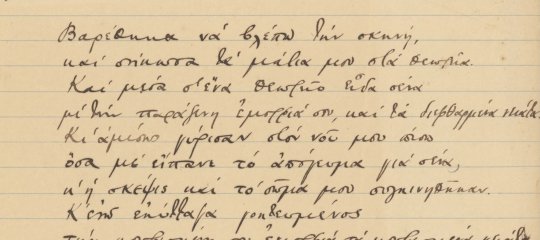Ενημέρωση για δραστηριότητες
lectrice writes, "
Εύη Παπαγιαννοπούλου
Ενημέρωση για δραστηριότητες που οργάνωσε η Εύη Παπαγιαννοπούλου για την προώθηση της Ελληνικής Παιδείας και Πολιτισμού στο Πανεπιστήμιο της ΜΟΝΣ-ΑΙΝΩ κατά το ακαδημαϊκό έτος 2007-2008
"
2 Ιουνίου 2008
1.Η Σχολή Διεθνών Διερμηνέων του Πανεπιστημίου της Μονς Βελγίου πραγματοποίησε ταξίδι στην Ελλάδα από τις 12 έως τις 19 Ιανουαρίου 2008.
Οι πρωτοετείς φοιτητές είχαν έτσι την ευκαιρία να συμμετάσχουν σε αρχαιολογική και ιστορική περιήγηση των σημαντικότερων μνημείων και πόλεων της Πελοποννήσου και της Κεντρικής Ελλάδας. Το ταξίδι οργάνωσε η κ . Εύη Παπαγιαννοπούλου, Λέκτορας αποσπασμένη στο Πανεπιστήμιο, στα πλαίσια του μαθήματός Τέχνης και Πολιτισμού που διδάσκει η ίδια. Επίσης, ξέναγησε αυτοπροσώπως την αποστολή, υπό την ιδιότητά της επισήμης ξεναγού του Ελληνικού Υπουργείου Τουρισμού, στους παρακάτω μνημειακούς χώρους και μουσεία: Αρχαία Κόρινθο, Επίδαυρο, Μυκήνες, Ολυμπία, Σπάρτη, Μυστρά, Δελφούς, Οσιο Λουκά, Ακρόπολη , Αρχαία Αγορά και Αρχαιολογικό Μουσείο Αθηνών
Με την ευκαιρία της διέλευσής της από την Αθήνα, η ομάδα επισκεφθηκε τό Υπουργείο Πολιτισμού, Διεύθυνση Διεθνών Σχέσεων, Τμήμα Διακρατικών Σχέσεων και εξέφρασε τις ευχαριστίες της για την υποστήριξη που έλαβε σε σχέση με την πραγματοποίηση του ταξιδιού, επιδίδοντας αναμνηστικό μετάλλιο του Πανεπιστημίου στη Διεύθυνση .
Les étudiants de l’E.I.I ont eu l’opportunité de participer à un voyage organisé en Grèce par le professeur des G.C.A. du 12 au 19 janvier 2008 pour y découvrir son patrimoine monumental et historique. Un circuit de 8 jours en autocar avec logement en hôtel, 2 à 4 étoiles, en demi-pension a permis aux étudiants de la 1ère bachelier de sillonner le Péloponnèse, la Phocide et la Béotie, ainsi que la ville d Athènes. Corinthe, Epidaure, Mycènes, Olympie, Sparte et Mystras, Delphes, Hossios Loukas et l’Acropole d’Athènes constituaient les étapes les plus importantes de notre parcours.
Les musées et les monuments visités ont été présentés par
Madame E. Papayannopoulou en illustration des matières théoriques abordées en amphithéâtre dans le cadre de son cours. Le groupe a été reçu en délégation au Ministère de la Culture grec, Division des Relations Internationales.
2. Με την ευκαιρία των εορτών του τέλους του έτους, οι παλιοί και νέοι φοιτητές της κας Ε. Παπαγιαννοπούλου στο Πανεπιστήμιο της Μονς συγκέντρωθηκαν στο Jazz Club «Sound’s», στις Βρυξέλλες.
Η συνάντηση αυτή έδωσε την ευκαιρια για τη βολιδοσκόπηση της δυνατότητας υλοποίησης του σχεδίου της ίδρυσης μη Κεδοσκοπικού Σωματείου που θα αποσκοπεί στην αλληλοϋποστήριξη και στην επαγγελματική αποκατάστση των νέων μεταφραστών ελληνικής γλώσσας. Φωτογραφικό ρεπορτάζ της βραδιάς παρουσίαζεται στην ιστοσελίδα του Συλλόγου φοιτητών της Σχολής AGE
A l’occasion des fêtes de fin d’année, les anciens et les nouveaux étudiants de
Madame Payannopoulou à l’E. I. I et à l’Institut de Linguistique se sont réunis en décembre dernier au Jazz Club « Sound’s » à 1050 Bruxelles, rue des Tulipes, Place Fernand Coq, Ixelles.
Cet événement a offert l’opportunité de prospecter l’éventualité de constitution d’une ASBL. Cette association aura pour but l’entraide et l’intégration professionnelle de jeunes traducteurs de langue grecque au sein de laquelle ils pourront désormais se retrouver et échanger.
3.Νέες εκδόσεις: Τέθηκαν σε κυκλοφορία από τις εκδόσεις του Πανεπιστημίου της Μονς / Presses Universitaires de Mons τα εξής συγγράμματα της Εύης Παπαγιαννοπούλου :
a) Ελληνικός Πολιτισμός, Civilisation grecque
b)Η Ελληνική Μυθολογία στις Βρυξέλλες, Οδηγός του Επισκέπτη
La Mythologie Grecque révisitée à Bruxelles
c)H Ορολογία της Τέχνης, Πεντάγλωσσο γλωσσάριο ,
La Terminologie de l’Art, en 5 langues
d)Τα Μεγάλα Ρεύματα της Τέχνης, 2 τόμοι Les grands Courants Artistiques
Τα ανωτέρω συγγράμματα διατίθενται και για το ευρύτερο κοινό κατόπιν παραγγελίας στη διεύθυνση των Presses Universitaires de Mons.
Ο "Οδηγός του Επισκέπτη των Μυθολογικών Βρυξελλών" έχει ήδη δοκιμαστεί επί του πεδίου από Σχολεία της γαλλόφωνης Κοινότητας του Βελγίου με τη μορφή ράλλυ ή εκπαιδευτικών επισκέψεων και εντάσσεται σε ευρύτερο πρόγραμμα κατάρτισης των διδασκόντων τις "Αρχαίες γλώσσες " (Ελληνικά και Λατινικά)
- Εμείς /
- Εισέλθετε στο σύστημα για να υποβάλετε σχόλια










